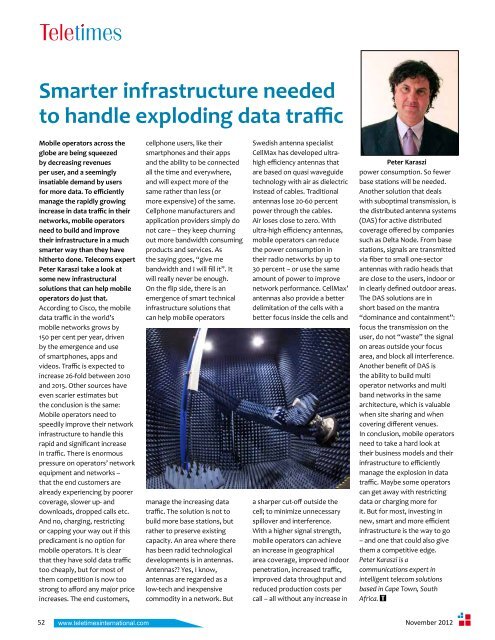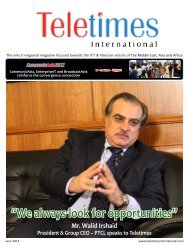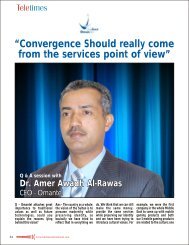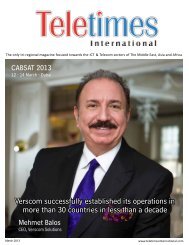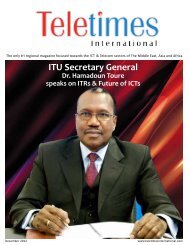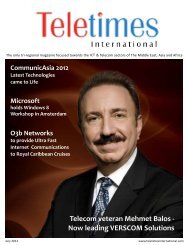GITEX 2012 INTERVIEWS ITU TELECOM World 2012 - Teletimes
GITEX 2012 INTERVIEWS ITU TELECOM World 2012 - Teletimes
GITEX 2012 INTERVIEWS ITU TELECOM World 2012 - Teletimes
Create successful ePaper yourself
Turn your PDF publications into a flip-book with our unique Google optimized e-Paper software.
Smarter infrastructure neededto handle exploding data trafficMobile operators across theglobe are being squeezedby decreasing revenuesper user, and a seeminglyinsatiable demand by usersfor more data. To efficientlymanage the rapidly growingincrease in data traffic in theirnetworks, mobile operatorsneed to build and improvetheir infrastructure in a muchsmarter way than they havehitherto done. Telecoms expertPeter Karaszi take a look atsome new infrastructuralsolutions that can help mobileoperators do just that.According to Cisco, the mobiledata traffic in the world’smobile networks grows by150 per cent per year, drivenby the emergence and useof smartphones, apps andvideos. Traffic is expected toincrease 26-fold between 2010and 2015. Other sources haveeven scarier estimates butthe conclusion is the same:Mobile operators need tospeedily improve their networkinfrastructure to handle thisrapid and significant increasein traffic. There is enormouspressure on operators’ networkequipment and networks –that the end customers arealready experiencing by poorercoverage, slower up- anddownloads, dropped calls etc.And no, charging, restrictingor capping your way out if thispredicament is no option formobile operators. It is clearthat they have sold data traffictoo cheaply, but for most ofthem competition is now toostrong to afford any major priceincreases. The end customers,cellphone users, like theirsmartphones and their appsand the ability to be connectedall the time and everywhere,and will expect more of thesame rather than less (ormore expensive) of the same.Cellphone manufacturers andapplication providers simply donot care – they keep churningout more bandwidth consumingproducts and services. Asthe saying goes, “give mebandwidth and I will fill it”. Itwill really never be enough.On the flip side, there is anemergence of smart technicalinfrastructure solutions thatcan help mobile operatorsmanage the increasing datatraffic. The solution is not tobuild more base stations, butrather to preserve existingcapacity. An area where therehas been radid technologicaldevelopments is in antennas.Antennas?? Yes, I know,antennas are regarded as alow-tech and inexpensivecommodity in a network. ButSwedish antenna specialistCellMax has developed ultrahighefficiency antennas thatare based on quasi waveguidetechnology with air as dielectricinstead of cables. Traditionalantennas lose 20-60 percentpower through the cables.Air loses close to zero. Withultra-high efficiency antennas,mobile operators can reducethe power consumption intheir radio networks by up to30 percent – or use the sameamount of power to improvenetwork performance. CellMax’antennas also provide a betterdelimitation of the cells with abetter focus inside the cells anda sharper cut-off outside thecell; to minimize unnecessaryspillover and interference.With a higher signal strength,mobile operators can achievean increase in geographicalarea coverage, improved indoorpenetration, increased traffic,improved data throughput andreduced production costs percall – all without any increase inPeter Karaszipower consumption. So fewerbase stations will be needed.Another solution that dealswith suboptimal transmission, isthe distributed antenna systems(DAS) for active distributedcoverage offered by companiessuch as Delta Node. From basestations, signals are transmittedvia fiber to small one-sectorantennas with radio heads thatare close to the users, indoor orin clearly defined outdoor areas.The DAS solutions are inshort based on the mantra“dominance and containment”:focus the transmission on theuser, do not “waste” the signalon areas outside your focusarea, and block all interference.Another benefit of DAS isthe ability to build multioperator networks and multiband networks in the samearchitecture, which is valuablewhen site sharing and whencovering different venues.In conclusion, mobile operatorsneed to take a hard look attheir business models and theirinfrastructure to efficientlymanage the explosion in datatraffic. Maybe some operatorscan get away with restrictingdata or charging more forit. But for most, investing innew, smart and more efficientinfrastructure is the way to go– and one that could also givethem a competitive edge.Peter Karaszi is acommunications expert inintelligent telecom solutionsbased in Cape Town, SouthAfrica.52 November <strong>2012</strong>www.teletimesinternational.com


